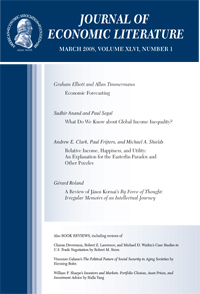十年证据:欺诈是金融危机的主因吗?
IF 10.6
1区 经济学
Q1 ECONOMICS
引用次数: 0
摘要
本文综合了2008-09年美国住房和金融危机中心有关住宅抵押贷款支持证券(RMBS)证券化中各参与者角色的大量文献。承销银行通过故意谎报抵押贷款支持证券(MBS)的关键贷款特征,为大规模抵押贷款欺诈提供了便利。在复杂性的掩护下,信用评级机构通过对RMBS和债务抵押债券(cdo)日益夸大的评级来迎合投资银行。从事抵押贷款欺诈的发起人获得了市场份额,通过接受质量最低的MBS抵押品来迎合承销商的CDO经理也获得了市场份额。考核目标化和虚高的考核是常态。RMBS和CDO的价格表明,边际AAA级投资者没有意识到普遍存在的抵押贷款欺诈和评级通胀,但这些因素与未来的交易表现密切相关。欺诈性信贷的供应并不统一,而是集中在某些地理区域和邮政编码。当这些可疑的发起人向那些无力偿还贷款的人提供信贷时,信贷扩张导致了这些邮政编码地区的房价暴涨和随后的崩盘。总体而言,基于大量研究的一致叙述表明,利益冲突、误报和欺诈是金融危机的主要特征。(凝胶g01, g21, g28, k42, r30)本文章由计算机程序翻译,如有差异,请以英文原文为准。
Ten Years of Evidence: Was Fraud a Force in the Financial Crisis?
This article synthesizes the large literature regarding the role of various players in residential mortgage-backed securities (RMBS) securitization at the center of the 2008–09 US housing and financial crisis. Underwriting banks facilitated wide-scale mortgage fraud by knowingly misreporting key loan characteristics underlying mortgage-backed securities (MBS). Under the cover of complexity, credit rating agencies catered to investment banks by issuing increasingly inflated ratings on both RMBS and collateralized debt obligations (CDOs). Originators who engaged in mortgage fraud gained market share, as did CDO managers who catered to underwriters by accepting the lowest-quality MBS collateral. Appraisal targeting and inflated appraisals were the norm. RMBS and CDO prices indicate that the marginal AAA investor was unaware of pervasive mortgage fraud and ratings inflation, but these factors were strongly related to future deal performance. The supply of fraudulent credit was not uniform, but clustered in certain geographic regions and zip codes. As these dubious originators extended credit to those who could not afford the loans, the credit expansion led to house price booms and subsequent crashes in these zip codes. Overall, a consistent narrative based on substantial research indicates that conflicts of interest, misreporting, and fraud were focal features of the financial crisis. (JEL G01, G21, G28, K42, R30)
求助全文
通过发布文献求助,成功后即可免费获取论文全文。
去求助
来源期刊

Journal of Economic Literature
ECONOMICS-
CiteScore
17.80
自引率
0.80%
发文量
49
期刊介绍:
Commencing in 1969, the Journal of Economic Literature (JEL) serves as a vital resource for economists, offering a means to stay informed about the extensive literature in the field. Each JEL issue features commissioned, peer-reviewed survey and review articles, book reviews, an annotated bibliography categorizing new books by subject, and an annual index of dissertations from North American universities.
 求助内容:
求助内容: 应助结果提醒方式:
应助结果提醒方式:


